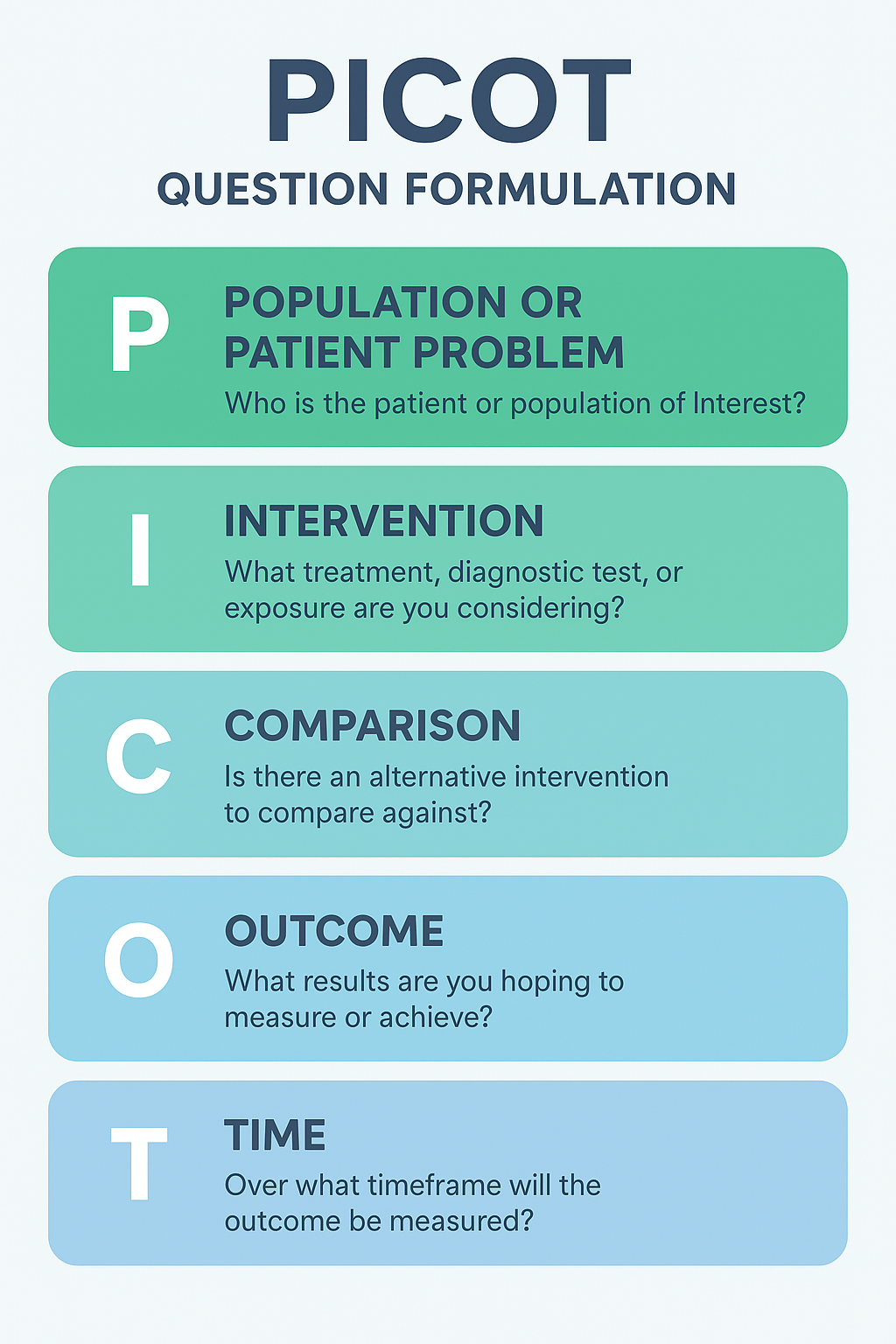A Guide to PICOT Question Formulation in Evidence-Based Practice
Evidence-based practice (EBP) is the foundation of modern healthcare decision-making. At its core is the ability to ask clear, structured, and answerable clinical questions. One of the most effective frameworks for this is the PICOT model, which helps clinicians, researchers, and students break down complex problems into manageable components.
This article explores what PICOT is, why it matters, and how to formulate strong PICOT questions.
What Is PICOT?
PICOT is an acronym that represents five elements essential for building a focused clinical research question:
-
P (Population or Patient Problem): Who is the patient or population of interest? Consider age, gender, diagnosis, or specific health conditions.
-
I (Intervention): What treatment, diagnostic test, or exposure are you considering?
-
C (Comparison): Is there an alternative intervention to compare against? This could be a placebo, a different treatment, or standard care.
-
O (Outcome): What results are you hoping to measure or achieve? Outcomes can be improvements, complications, side effects, or patient satisfaction.
-
T (Time): Over what timeframe will the outcome be measured? This element is optional but often useful for specificity.
By including these elements, PICOT questions are more focused and researchable, making it easier to locate high-quality evidence.
Why Use the PICOT Framework?
Formulating questions without structure can lead to vague, unmanageable searches that waste time and effort. Using PICOT ensures:
-
Clarity: Each component of the question is well-defined.
-
Efficiency: Database searches yield more relevant results.
-
Consistency: Healthcare teams use a common framework to analyze problems.
-
Evidence-based decisions: Well-formed questions improve the quality of the clinical evidence identified.
Steps to Formulate a PICOT Question
-
Identify the Clinical Issue
Begin with a real-world patient problem or knowledge gap. For example, you might notice uncertainty about which intervention leads to better outcomes in managing post-surgical pain. -
Break the Issue into PICOT Elements
-
P: Adults recovering from abdominal surgery
-
I: Non-opioid pain management strategies
-
C: Standard opioid-based pain management
-
O: Patient-reported pain levels and functional recovery
-
T: First 48 hours after surgery
-
-
Formulate the Question
In adults recovering from abdominal surgery (P), how does non-opioid pain management (I) compared to opioid-based pain management (C) affect pain levels and functional recovery (O) within the first 48 hours post-surgery (T)?
Examples of PICOT Questions
-
Nursing Practice:
In elderly patients at risk of falls (P), does implementing hourly rounding (I) compared to standard care (C) reduce fall rates (O) during hospitalization (T)? -
Public Health:
In adolescents (P), does participation in school-based mental health programs (I) compared to no formal program (C) improve reported resilience and coping skills (O) over six months (T)? -
Pharmacology:
In patients with hypertension (P), does a low-sodium diet (I) compared to standard dietary habits (C) lower systolic blood pressure (O) within three months (T)?
Tips for Writing Strong PICOT Questions
-
Be as specific as possible with the population and intervention.
-
If no natural comparison exists, it’s acceptable to leave the C element blank.
-
Choose outcomes that are measurable and meaningful in clinical practice.
-
Use T when time plays a critical role, such as in acute vs. chronic interventions.
Conclusion
Formulating questions using the PICOT framework is an essential skill for healthcare professionals, researchers, and students. It transforms broad problems into precise, researchable queries that guide evidence-based decision-making. Whether you’re conducting a literature review, designing a study, or making clinical decisions, PICOT provides the structure needed to find reliable answers.



